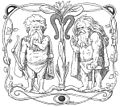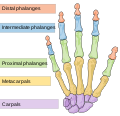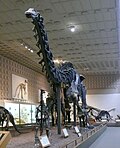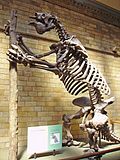A forelimb or front limb is one of the paired articulated appendages (limbs) attached on the cranial (anterior) end of a terrestrial tetrapod vertebrate's...
16 KB (1,926 words) - 04:26, 22 August 2024
Theropoda (section Forelimb morphology)
universal: spinosaurids had well developed forelimbs, as did many coelurosaurs. The relatively robust forelimbs of one genus, Xuanhanosaurus, led D. Zhiming...
71 KB (7,618 words) - 01:13, 22 August 2024
Limbs of the horse (redirect from Equine forelimb anatomy)
includes the horse, as the sole surviving genus of the Equidae family. Each forelimb of the horse runs from the scapula or shoulder blade to the third phalanx...
27 KB (3,503 words) - 22:40, 11 August 2024
Shoulder girdle (redirect from Forelimb girdle)
In those species having only the scapula, no joint exists between the forelimb and the thorax, the only attachment being muscular. The shoulder girdle...
15 KB (1,853 words) - 05:08, 15 August 2024
MCPJ or a MTPJ) is formed by the junction of the third metacarpal (in the forelimb) or metatarsal (in the hindlimb) bones, either of which are commonly called...
3 KB (344 words) - 00:09, 18 June 2024
The paw consists of the large, heart-shaped metacarpal or palmar pad (forelimb) or metatarsal or plantar pad (rear limb), and generally four load-bearing...
3 KB (314 words) - 19:17, 29 February 2024
Bat wing development (section Elongation of forelimb)
unique mammalian adaptation of flight. Bat wings are modified tetrapod forelimbs. Because bats are mammals, the skeletal structures in their wings are...
11 KB (1,320 words) - 18:05, 13 June 2022
Acrocanthosaurus (section Forelimb function)
allowing for specialized studies focusing on its brain structure and forelimb function. Acrocanthosaurus was the largest theropod in its ecosystem and...
50 KB (5,245 words) - 21:06, 29 June 2024
long, heavy tail. Relative to its large and powerful hind limbs, the forelimbs of Tyrannosaurus were short but unusually powerful for their size, and...
217 KB (23,943 words) - 18:33, 24 August 2024
Flexion test (section Upper forelimb flexion)
found during physical examination. Flexion may be performed by lifting the forelimb (antebrachium) so that it is parallel to the ground, while allowing the...
8 KB (1,269 words) - 22:51, 16 October 2021
characteristics or adaptations, such as possessing opposable anterior forelimb-appendages (i.e. thumbs), visible spectrum-binocular vision (i.e. having...
17 KB (2,017 words) - 06:18, 25 August 2024
Bird wings are a paired forelimb in birds. The wings give the birds the ability to fly, creating lift. Terrestrial flightless birds have reduced wings...
7 KB (878 words) - 13:30, 25 July 2023
The hindlimb attaches to the vertebral column via the pelvis, while the forelimb does not directly attach to the spine (as a horse does not have a collar...
15 KB (2,137 words) - 07:37, 9 August 2024
Cling/forelimb-suspend: One of the forelimbs is hanging causing more than half the weight to be put the hindlimbs and the clinging forelimb. Forelimb-suspend:...
18 KB (2,202 words) - 17:29, 16 December 2023
example a forelimb bud, could be transplanted to another part of the embryo and in ongoing individual development still give rise to a forelimb at an odd...
9 KB (1,019 words) - 19:58, 21 June 2024
prehensile, multi-fingered appendage located at the end of the forearm or forelimb of primates such as humans, chimpanzees, monkeys, and lemurs. A few other...
40 KB (4,555 words) - 13:24, 26 July 2024
had semierect hind limbs); Permian carnivorous therapsids had sprawling forelimbs, and some late Permian ones also had semisprawling hindlimbs. In fact...
221 KB (23,066 words) - 19:14, 23 August 2024
The cranial pair (i.e. closer to the head) of limbs are known as the forelimbs or front legs, and the caudal pair (i.e. closer to the tail or coccyx)...
8 KB (1,002 words) - 11:28, 28 March 2024
Diamantinasaurus (section Forelimb)
of the holotype and paratype. The known skeleton includes most of the forelimb, shoulder girdle, pelvis, hindlimb and ribs of the holotype, and one shoulder...
34 KB (3,355 words) - 16:11, 21 August 2024
gene that is required for the development of the front extremities or forelimbs such as long arms. The other is COL1A1, which is responsible for the development...
34 KB (3,508 words) - 06:44, 27 July 2024
to curl and, instead developed forelimbs would be favored by achieving completely crossed pathways as long as forelimbs were primarily occupied in a lateral...
39 KB (5,089 words) - 14:49, 11 May 2024
(hoofed mammals) the forelimb is optimized for speed and endurance by a combination of length of stride and rapid step; the proximal forelimb segments are short...
22 KB (2,465 words) - 15:39, 2 August 2024
each rear limb-- although two-toed sloths have only two digits on each forelimb. The two groups of sloths are from different, distantly related families...
50 KB (5,420 words) - 09:47, 15 August 2024
contrast to its lightly built relatives Diplodocus and Barosaurus. The forelimbs were short and stout whereas the hindlimbs were elongated and thick, supported...
95 KB (10,281 words) - 15:02, 23 August 2024
on the humerus, suggesting to Cuvier that the animal probably used its forelimbs to grasp. A later publication in 1823 by Cuvier suggested that giant carapaces...
51 KB (5,545 words) - 20:26, 22 August 2024
(upper bone of the forelimb) is called the glenoid. The scapula serves as the attachment site for a dinosaur's back and forelimb muscles.[citation needed]...
33 KB (3,762 words) - 08:55, 17 August 2024
are flying mammals of the order Chiroptera (/kaɪˈrɒptərə/). With their forelimbs adapted as wings, they are the only mammals capable of true and sustained...
169 KB (18,242 words) - 00:14, 28 July 2024
possess atypical forelimb morphologies, such as the hooved forelimbs of the pig-footed bandicoot, suggesting that the range of forelimb specialization is...
75 KB (7,760 words) - 00:21, 14 August 2024
are considered a run. Forelimb-hindlimb phase is the temporal relationship between the limb pairs. If the same-side forelimbs and hindlimbs initiate...
13 KB (1,645 words) - 07:32, 12 July 2024
on the scapula where it articulated with the humerus (upper bone of the forelimb) is the called the glenoid. The clavicles fused in some theropod dinosaurs...
18 KB (2,063 words) - 17:56, 23 August 2024

























